Hyundai i30
The Hyundai i30 is a small family car manufactured by the South Korean manufacturer Hyundai Motor Company in Nošovice, Czech Republic, since 2007. The i30 shares its platform with the Kia Cee'd, available as a three-door hatchback (2012–2017), five door hatchback, five-door estate and five-door fastback (2017–present), with a choice of three petrol engines and two diesel engines, either with manual or automatic transmission.
| Hyundai i30 | |
|---|---|
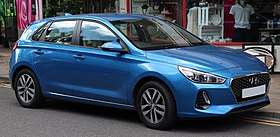 | |
| Overview | |
| Manufacturer | Hyundai Motor Company |
| Production | 2007–present |
| Body and chassis | |
| Class | Small family car (C) |
| Body style | 3-door hatchback (i30 Coupe) (2012–2017) 5-door hatchback 5-door estate 5-door liftback (i30 Fastback) (2017–present) 4-door sedan (Australia) (2020-present) |
| Layout | Front-engine, front-wheel-drive |
| Related | Hyundai Elantra Kia Cee'd Kia Forte |
| Chronology | |
| Predecessor | Hyundai Elantra (for hatchback variant 2000-2006) |
The i30 is marketed alongside the fifth-generation Hyundai Elantra in the United States and Canada as the Hyundai Elantra GT, formerly as the Elantra Touring. The second-generation i30 was introduced in September 2011 at the Frankfurt Auto Show in Frankfurt, Germany.
First generation (FD; 2007–2012)
| First generation (FD) | |
|---|---|
_SX_hatchback_(2016-01-04)_01.jpg) | |
| Overview | |
| Also called | Hyundai Elantra Touring (United States, Canada; wagon) Beijing-Hyundai i30 (China)[1] |
| Production | 2007–2012 |
| Assembly | Ulsan, South Korea Nošovice, Czech Republic Beijing, China Cairo, Egypt (Ghabbour Group) |
| Designer | Thomas Bürkle[2] |
| Body and chassis | |
| Body style | 5-door hatchback 5-door estate (i30 CW) |
| Platform | Hyundai-Kia J4 platform |
| Related | Hyundai Elantra (HD) Kia Cee'd (ED) |
| Powertrain | |
| Engine | 1.4 L I4 1.6 L I4 Gamma 2.0 L I4 Beta II 1.6 L I4 CRDi 2.0 L I4 CRDi |
| Transmission | 5-speed manual 6-speed manual 4-speed automatic |
| Dimensions | |
| Wheelbase | 2,650 mm (104.3 in) (hatchback) 2,700 mm (106.3 in) (wagon) |
| Length | 4,245 mm (167.1 in) (hatchback) 4,475 mm (176.2 in) (wagon) |
| Width | 1,775 mm (69.9 in) |
| Height | 1,480 mm (58.3 in) (hatchback) 1,565 mm (61.6 in) (wagon) |
It was conceived in Rüsselsheim, Germany, at Hyundai's Design and Technical Centre.
The i30 scored a 4.2 on the Euro NCAP crash tests for the 2008[3] model, and is an improvement on the 3.9 scored during the 2007[4] model.
| Euro NCAP test results | ||
|---|---|---|
| Hyundai i30 (2007) | ||
| Test | Score | Rating |
| Adult occupant: | 33 | |
| Child occupant: | 34 | |
| Pedestrian: | 14 | |
| Euro NCAP test results | ||
|---|---|---|
| Hyundai i30 (2008) | ||
| Test | Score | Rating |
| Adult occupant: | 34 | |
| Child occupant: | 38 | |
| Pedestrian: | 14 | |
The i30 awarded the full five star safety rating by the Australasian New Car Assessment Program.[5]
The i30 named as safest imported mid size car in Argentina.[6]
The first generation i30 was officially launched in Malaysia in July 2009[7] where two engines were available: 1.6L (manual and auto) and 2.0L (auto only).[8]
_SLX_hatchback_(2018-10-01)_02.jpg)
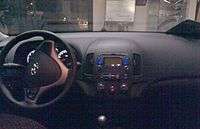
_SX_station_wagon_02.jpg)
.jpg)
i30cw
The i30 hatchback was introduced at the Geneva Motor Show in March 2007, and released in July 2007 for Europe and Australia. The i30cw (a.k.a. i30 estate, also known as Elantra Touring) was released in South Korea at the Seoul Motor Show in 2007,[9] and is marketed worldwide under slightly different names. This model also entered the North American market for the model year of 2009, as the Elantra Touring. It is a larger, more roomy version of the i30 hatchback. The i30 cw's maximum cargo volume is 65 cubic feet (1,800 L).
For the model year of 2012, the Elantra Touring wagon came with a 2.0-litre inline-four producing 138 hp (103 kW) and 136 lb⋅ft (184 N⋅m). The American EPA rates consumption at 23 MPG in the city and 30 MPG on the highway (10 L/100 km and 7.8 L/100 km respectively). The Elantra Touring comes equipped with either a five-speed manual or a four-speed automatic transmission.[10]
The Hyundai Elantra Touring was originally available in either Base or Limited trim, each offering a similar level of equipment to its Hyundai Elantra sedan counterpart. Later the model names were changed to GLS and SE, with the SE being the more equipped model.
The i30cw/Elantra Touring scored high on the United States National Highway Traffic Safety Administration crash tests:[11]
- Frontal Crash:





- Side Crash:





- Roll Over:





i30 blue
The i30 blue is a variation with Start&Stop technology (called Idle Stop and Go). United Kingdom versions came with 1.4L, 1.6L petrol or a 1.6L diesel engine, in both five door hatchback or estate body styles. CO
2 emission rating for the 1.6L petrol models were reduced to 142g/km (from 152g/km).
The car was unveiled at the 2009 Geneva Motor Show, and was produced in Nosovice, Czech Republic. It went on sale in the United Kingdom in January 2008.[12] and had ISG as an option, costing £200.
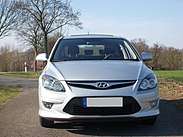 Hyundai i30 blue 1.6 sport
Hyundai i30 blue 1.6 sport Hyundai i30 blue 1.6 sport
Hyundai i30 blue 1.6 sport
Reception
In Australia, the Hyundai i30 won the 'Best Mid size Car Under $28,000'. At the time of its release in the end of 2007, the 1.6L CRDi i30 was the cheapest diesel car in Australia, coming in at just $21,490AUD for the basic (SX) model. The model above (SLX) adds Climate Control, trip computer, leather gear knob and steering wheel (with audio controls), cruise control (from 2008), body colour door handles, rear armrest with cup holders, six speakers (up from four), adjustable lumbar support for the driver, fog lights and 16" alloy wheels. Australian i30 models feature a unique suspension tune for Australian road conditions.
- 2007
Car of the Year for 2007 by Carsguide[13] with the 1.6L CRDi model winning the Green Car of the Year award.[14]
Hyundai's i30 Diesel Picked as Australia's Car of the Year.[15]
- 2008
'Best Mid-size Car Under $28,000' by Australia's Best Cars to the Hyundai i30 SX petrol and i30 CRDi Turbo Diesel [16]
The Hyundai i30 was chosen as 2008 Car of the Year in Spain.[17][18]
- 2009
Best Family Hatch in New Zealand
The Hyundai i30 was judged the Supreme Winner in the 2009 AA Motoring Excellence Awards in New Zealand.[19][20]
- 2010
Most Satisfying Car In Britain.
The i30 won the Driver Power Top 100 survey to be named by owners as the most satisfying car to own. Auto Express magazine surveyed the reliability and satisfaction survey, completed by over 23,000 drivers.[21][22]
The Hyundai Elantra Touring Named Top 10 Family Cars by Kelley Blue Book (KBB) in the United States.[23]
- 2012
Best Family Car. The i30 won the Best Family Car of the Year on 14 October 2012, at the Glasgow Thistle.
Engines
| Model | Engine | Power | Torque | 0–100 km/h (0–62 mph)[lower-alpha 1] |
Top speed[lower-alpha 1] | |
|---|---|---|---|---|---|---|
| Petrol engines | ||||||
| 1.4 | 1.4 L (1,396 cc) 16V I4 | 109 PS (80 kW; 108 hp) at 6200 rpm | 137.2 N⋅m (101.2 lbf⋅ft) at 5000 rpm | M: | 12.6 s | 187 km/h (116 mph) |
| 1.6 | 1.6 L (1,591 cc) 16V I4 | 126 PS (93 kW; 124 hp) at 6300 rpm | 154.0 N⋅m (113.6 lbf⋅ft) at 4200 rpm | M: | 11.1 s | 192 km/h (119 mph) |
| A: | 12.1 s | 183 km/h (114 mph) | ||||
| 2.0 | 2.0 L (1,975 cc) 16V I4 | 145 PS (107 kW; 143 hp) at 6000 rpm | 186 N⋅m (137 lbf⋅ft) at 4600 rpm | M: | 10.6 s | 205 km/h (127 mph) |
| A: | 10.6 s | 195 km/h (121 mph) | ||||
| Diesel engines | ||||||
| 1.6 CRDi | 1.6 L (1,582 cc) 16V turbo I4 | 90 PS (66 kW; 89 hp) at 4000 rpm | 235.0 N⋅m (173.3 lbf⋅ft) at 1750–2500 rpm | M: | 14.9 s | 172 km/h (107 mph) |
| 1.6 CRDi | 1.6 L (1,582 cc) 16V turbo I4 | 116 PS (85 kW; 114 hp) at 4000 rpm | 255.0 N⋅m (188.1 lbf⋅ft) at 1900–2750 rpm | M: | 11.6 s | 188 km/h (117 mph) |
| A: | 12.8 s | 180 km/h (112 mph) | ||||
| 1.6 CRDi U2 | 1.6 L (1,582 cc) 16V turbo I4 | 128 PS (94 kW; 126 hp) at 4000 rpm | 260.0 N⋅m (191.8 lbf⋅ft) at 1900–2750 rpm | M: | Unknown | Unknown |
| A: | Unknown | Unknown | ||||
| 2.0 CRDi | 2.0 L (1,991 cc) 16V turbo I4 | 140 PS (103 kW; 138 hp) at 3800 rpm | 304.0 N⋅m (224.2 lbf⋅ft) at 1900–2500 rpm | M: | 10.3 s | 205 km/h (127 mph) |
- Figures displayed for manual and automatic transmission versions.
Transmissions
Choices include a five speed manual, six speed manual (1.6 CRDi U2 and 2.0 CRDi), or four speed automatic transmission. Automatic transmissions are available with 1.6 petrol, 2.0 petrol, 1.6 CRDi (116PS) models.
Second generation (GD; 2011–2017)
| Second generation (GD) | |
|---|---|
_Trophy_5-door_hatchback_(2015-07-24)_01.jpg) | |
| Overview | |
| Also called | Hyundai Elantra GT (United States, Canada) |
| Production | 2011–2017 (28.04.2017 end of production in Nošovice) |
| Assembly | |
| Designer | Thomas Bürkle[2] |
| Body and chassis | |
| Body style | |
| Platform | Hyundai-Kia J4 platform |
| Related |
|
| Powertrain | |
| Engine | |
| Transmission | |
| Dimensions | |
| Wheelbase | 2,650 mm (104.3 in) |
| Length |
|
| Width | 1,780 mm (70.1 in) |
| Height | 1,470 mm (57.9 in) |
| Curb weight | 1,210–1,495 kg (2,668–3,296 lb) |
Hyundai unveiled its next generation i30 at the 2011 Frankfurt International Motor Show. The new i30 was designed and engineered at the Hyundai Motor Europe Technical Centre in Rüsselsheim, Germany, and offers a choice of four engines with a total of six power options and CO2 emissions below 100 g/km due to an upgraded 1.6 litre diesel unit. The next generation i30 went on sale in Europe early in 2012, as a five-door hatchback. It is produced in Europe at the company's manufacturing facility in Nošovice, Czech Republic.
It was launched in South Korea since October 20, 2011, and it is the second model under Hyundai's Premium Youth Lab brand. The new Korean spec i30 is offered with a 1.6L Gamma GDi engine and a 1.6L VGT diesel engine.
The second generation i30 became available in the United States in the summer of 2012, as the 2013 Hyundai Elantra GT, replacing the Elantra Touring nameplate. It made a premiere at the 2012 Chicago Auto Show, along with the new Hyundai Elantra Coupe,[24] featuring the same 1.8L Nu MPI engine as the original Elantra MD sedan. Available in a single trim level, the Elantra GT offered several different option packages which added additional features.
In Malaysia, the second generation i30 was previewed during the 2013 Kuala Lumpur International Motor Show[25] and officially launched in March 2014.[26] For Malaysia, the i30 used a 1.8L engine and a torsion beam setup for the rear suspension.[27]
i30 Estate
An estate, or wagon, version of the second-generation i30 was premiered at the 2012 Geneva Motor Show.[28] This model is also known as the i30 Tourer in some markets.
The wagon shares the same wheelbase as the hatchback and adds 185 mm in length. The increased length yields an extra 150 litres of boot capacity, taking the total to 528 litres. With the rear seats folded, the total cargo capacity is 1642 litres, an increase of 326 litres over the hatch.
i30 three door
Introduced in the beginning of 2013, the aim of the three door version is to attract younger buyers to the i30. The grille is given a more aggressive look than the five door model.
i30 Turbo
In 2015 Hyundai introduced hot hatch version of the i30.
_Trophy_5-door_hatchback_(2015-07-24)_02.jpg) Hyundai i30 five door (Australia; pre-facelift)
Hyundai i30 five door (Australia; pre-facelift)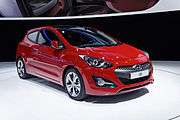 Hyundai i30 three door (Europe)
Hyundai i30 three door (Europe)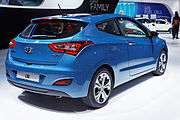 Hyundai i30 three door (Europe)
Hyundai i30 three door (Europe)_Active_Tourer_(2018-10-19).jpg) Hyundai i30 Tourer (Australia; pre facelift)
Hyundai i30 Tourer (Australia; pre facelift)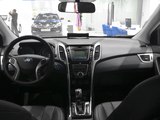 Interior
Interior Engine
Engine_Active_X_5-door_hatchback_(2015-08-07)_01.jpg) Hyundai i30 five door (Australia; facelift)
Hyundai i30 five door (Australia; facelift)
Engines
| Model | Built | Engine | Power | Torque | 0–100 km/h (0–62 mph)[lower-alpha 1] |
Top speed[lower-alpha 1] | Fuel cons. (per 100 km)[lower-alpha 1] | |
|---|---|---|---|---|---|---|---|---|
| Petrol engines | ||||||||
| 1.4 CVVT | 10/2011–9/2016 | 1.4 L (1,396 cc) 16V I4 | 99 PS (73 kW; 98 hp) at 5500 rpm | 137 N⋅m (101 lbf⋅ft) at 4200 rpm | M: | 13.2 s | 182 km/h (113 mph) | 6.0 L (NEDC) |
| 1.6 GDI | 10/2011–9/2016 | 1.6 L (1,591 cc) 16V I4 with direct injection | 135 PS (99 kW; 133 hp) at 6300 rpm | 164 N⋅m (121 lbf⋅ft) at 4850 rpm | M: | 9.9 s | 195 km/h (121 mph) | 5.7 L (NEDC) |
| A: | 11.0 s | 192 km/h (119 mph) | 6.7 L (NEDC) | |||||
| 1.8 CVVT | 10/2011–9/2016 | 1.8 L (1,797 cc) 16V I4 | 149 PS (110 kW; 147 hp) at 6500 rpm | 178 N⋅m (131 lbf⋅ft) at 4700 rpm | M: | 9.7 s | Unknown | 6.5 L (ADR): |
| A: | Unknown | Unknown | 6.9 L (ADR) | |||||
| 2.0 GDI | 2013–9/2016 | 2.0 L (1,999 cc) 16V I4 with direct injection | 175 PS (129 kW; 173 hp) at 6500 rpm | 209 N⋅m (154 lbf⋅ft) at 4700 rpm | M: | 7.7 s | Unknown | 7.2 L (ADR) |
| A: | 8.6 s | Unknown | 7.5 L (ADR) | |||||
| Diesel engines | ||||||||
| 1.4 CRDi | 10/2011–9/2016 | 1.4 L (1,396 cc) 16V turbo I4 with direct injection | 90 PS (66 kW; 89 hp) at 4000 rpm | 220 N⋅m (162 lbf⋅ft) at 1500–2750 rpm | M: | 13.5 s | 170 km/h (106 mph) | 4.1 L (NEDC) |
| 1.6 CRDi | 10/2011–9/2016 | 1.6 L (1,582 cc) 16V turbo I4 with direct injection | 110 PS (81 kW; 108 hp) at 4000 rpm | 280 N⋅m (207 lbf⋅ft) at 1500–3000 rpm | M: | 11.5 s | 185 km/h (115 mph) | 4.0 L (NEDC) |
| A | 12.3 s | 180 km/h (112 mph) | 5.5 L (NEDC) | |||||
| 1.6 CRDi | 10/2011–9/2016 | 1.6 L (1,582 cc) 16V turbo I4 with direct injection | 128 PS (94 kW; 126 hp) at 4000 rpm | 280 N⋅m (207 lbf⋅ft) at 1500–3000 rpm | M: | 10.9 s | 197 km/h (122 mph) | 4.1 L (NEDC) |
| A: | 11.7 s | 186 km/h (116 mph) | 5.5 L (NEDC) | |||||
| blue 1.6 CRDi | 10/2011–9/2016 | 1.6 L (1,582 cc) 16V turbo I4 with direct injection | 128 PS (94 kW; 126 hp) at 4000 rpm | 280 N⋅m (207 lbf⋅ft) at 1500–3000 rpm | M: | 10.9 s | 188 km/h (117 mph) | 3.7 L (NEDC) |
- Figures displayed for manual and automatic transmission versions.
2015 facelift engines
| Model | Engine | Comp. | Power | Torque | 0–100 km/h (0–62 mph)[lower-alpha 1] |
Top speed[lower-alpha 1] | Fuel cons. (per 100 km)[lower-alpha 1] | |
|---|---|---|---|---|---|---|---|---|
| Petrol engines | ||||||||
| 1.4 MPI | 1.4 L (1,368 cc) 16V I4 | 10.5:1 | 100 PS (74 kW; 99 hp) at 6000 rpm | 134 N⋅m (99 lbf⋅ft) at 3500 rpm | M: | 12.7 s | 183 km/h (114 mph) | 5.6 L (NEDC) |
| 1.6 GDI | 1.6 L (1,591 cc) 16V I4 with direct injection | 11.0:1 | 135 PS (99 kW; 133 hp) at 6300 rpm | 164 N⋅m (121 lbf⋅ft) at 4850 rpm | M: | 9.9 s | 195 km/h (121 mph) | 5.3 L (NEDC) |
| A: | 10.7 s | 195 km/h (121 mph) | 5.7 L (NEDC) | |||||
| 1.6 T-GDI | 1.6 L (1,591 cc) 16V turbo I4 with direct injection | 9.5:1 | 186 PS (137 kW; 183 hp) at 5500 rpm | 265 N⋅m (195 lbf⋅ft) at 1500-4500 rpm | M: | 8.0 s | 219 km/h (136 mph) | 7.3 L (NEDC) |
| Diesel engines | ||||||||
| 1.4 CRDi | 1.4 L (1,396 cc) 16V turbo I4 with direct injection | 17.0:1 | 90 PS (66 kW; 89 hp) at 4000 rpm | 220 N⋅m (162 lbf⋅ft) at 1500-2500 rpm | M: | 13.5 s | 173 km/h (107 mph) | 4.2 L (NEDC) |
| 1.6 CRDi | 1.6 L (1,582 cc) 16V turbo I4 and direct injection | 17.3:1 | 136 PS (100 kW; 134 hp) at 4000 rpm | 280 N⋅m (207 lbf⋅ft) at 1500–3000 rpm 300 N⋅m (221 lbf⋅ft) at 1750–2500 rpm[lower-alpha 2] |
M: | 10.2 s | 197 km/h (122 mph) | 3.8 L (NEDC) |
| D: | 10.6 s | 200 km/h (124 mph) | 4.2 L (NEDC) | |||||
| Model | Engine | Comp. | Power | Torque | 0–100 km/h (0–62 mph)[lower-alpha 1] |
Top speed[lower-alpha 1] | Fuel cons. (per 100 km)[lower-alpha 1] | |
|---|---|---|---|---|---|---|---|---|
| Petrol engines | ||||||||
| 1.4 MPI | 1.4 L (1,368 cc) 16V I4 | 10.5:1 | 100 PS (74 kW; 99 hp) at 6000 rpm | 134 N⋅m (99 lbf⋅ft) at 3500 rpm | M: | 13.0 s | 181 km/h (112 mph) | 5.6 L (NEDC) |
| 1.6 GDI | 1.6 L (1,591 cc) 16V I4 with direct injection | 11.0:1 | 135 PS (99 kW; 133 hp) at 6300 rpm | 164 N⋅m (121 lbf⋅ft) at 4850 rpm | M: | 10.2 s | 192 km/h (119 mph) | 5.9 L (NEDC) |
| A: | 11.0 s | 193 km/h (120 mph) | 5.7 L (NEDC) | |||||
| Diesel engines | ||||||||
| 1.4 CRDi | 1.4 L (1,396 cc) 16V turbo I4 with direct injection | 17.0:1 | 90 PS (66 kW; 89 hp) at 4000 rpm | 220 N⋅m (162 lbf⋅ft) at 1500-2500 rpm | M: | 13.9 s | 172 km/h (107 mph) | 4.2 L (NEDC) |
| 1.6 CRDi | 1.6 L (1,582 cc) 16V turbo I4 and direct injection | 17.3:1 | 136 PS (100 kW; 134 hp) at 4000 rpm | 280 N⋅m (207 lbf⋅ft) at 1500–3000 rpm 300 N⋅m (221 lbf⋅ft) at 1750–2500 rpm[lower-alpha 2] |
M: | 10.5 s | 194 km/h (121 mph) | 3.9 L (NEDC) |
| D: | 10.9 s | 197 km/h (122 mph) | 4.2 L (NEDC) | |||||
- Figures displayed for manual and automatic transmission versions.
- 7-speed DCT automatic
Third generation (PD; 2016–present)
| Third generation (PD) | |
|---|---|
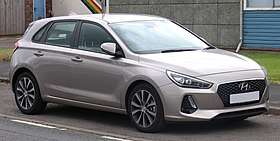 | |
| Overview | |
| Also called | Hyundai Elantra GT (United States, Canada) |
| Production | 2016–present |
| Assembly | Nosovice, Czech Republic Ulsan, South Korea Tiaret, Algeria [29] |
| Designer | Peter Schreyer[30] |
| Body and chassis | |
| Body style | 5-door hatchback 5-door estate (i30 Wagon) 5-door liftback (i30 Fastback) |
| Platform | Hyundai-Kia J6 platform |
| Related | Hyundai Elantra Kia Ceed |
| Powertrain | |
| Engine | 1.4 MPi (Petrol) 1.0 T-GDi (Petrol) 1.6 Gamma MPi (Petrol) 2.0 Nu GDi (Petrol) 1.6 Gamma T-GDi (Petrol) 1.4 T-GDi (Petrol) 1.6 CRDi (Diesel) 2.0 T-GDi (Petrol) |
| Transmission | 6-Speed Manual transmission 6-Speed Automatic transmission 7-Speed DCT |
| Dimensions | |
| Wheelbase | 2,650 mm (104.3 in) |
| Length | 4,340 mm (170.9 in) (Hatch) 4,585 mm (180.5 in) (Wagon) |
| Width | 1,795 mm (70.7 in) |
| Height | 1,450–1,455 mm (57.1–57.3 in) (Hatch) 1,475 mm (58.1 in) (Wagon) |
| Curb weight | 1,197–1,520 kg (2,639–3,351 lb) |
Hyundai unveiled the third generation i30 at the 2016 Paris Motor Show.[30] The car was designed by Peter Schreyer, and introduced a new design language for the brand called "Cascading grille" .[30] For the 2019 model year, Hyundai standardized the i30 Fastback front design, for all i30 versions. (Excluding the i30 N-line and i30N models)
The Hyundai i30 Fastback replaced Elantra in EU markets where it was being sold until Autumn 2017, where it was being presented at the Frankfurt Motor Show.
Engines
| Model | Engine | Power | Torque | 0–100 km/h (0–62 mph) |
Top Speed | |
|---|---|---|---|---|---|---|
| Petrol engines | ||||||
| 1.4 Kappa II MPi | 1.4 L (1,368 cc) I4 | 100 PS (74 kW; 99 hp) @ 6000 rpm | 134 N⋅m (99 lbf⋅ft) @ 4000 rpm | M: | 12.7 s | 183 km/h (114 mph) |
| 1.0 Kappa II T-GDi | 1.0 L (998 cc) I3 | 120 PS (88 kW; 118 hp) @ 6000 rpm | 171 N⋅m (126 lbf⋅ft) @ 1500-4500 rpm | M: | 11.1 s | 190 km/h (118 mph) |
| 1.6 Gamma II MPi | 1.6 L (1,591 cc) I4 | 128 PS (94 kW; 126 hp) @ 6300 rpm | 155 N⋅m (114 lbf⋅ft) @ 4850 rpm | M: | 10.5 s | 195 km/h (121 mph) |
| A: | 11.5 s | 192 km/h (119 mph) | ||||
| 1.4 Kappa II T-GDi | 1.4 L (1,353 cc) I4 | 140 PS (103 kW; 138 hp) @ 6000 rpm | 242 N⋅m (178 lbf⋅ft) @ 1500-3200 rpm | M: | 8.9 s | 210 km/h (130 mph) |
| D: | 9.2 s | 205 km/h (127 mph) | ||||
| 2.0 Nu GDi | 2.0 L (1,999 cc) I4 | 164 PS (121 kW; 162 hp) @ 6200 rpm | 203 N⋅m (150 lbf⋅ft) @ 4700 rpm | M: | 8.9 s | 210 km/h (130 mph) |
| A: | 9.2 s | 208 km/h (129 mph) | ||||
| 1.6 Gamma II T-GDi | 1.6 L (1,591 cc) I4 | 204 PS (150 kW; 201 hp) @ 6000 rpm | 265 N⋅m (195 lbf⋅ft) @ 1500-4500 rpm | M: | 7.5 s | 221 km/h (137 mph) |
| D: | 7.2 s | 220 km/h (137 mph) | ||||
| 2.0 Theta II T-GDi | 2.0 L (1,999 cc) I4 | 250 PS (184 kW; 247 hp) @ 6000 rpm 275 PS (202 kW; 271 hp) @ 6000 rpm |
353 N⋅m (260 lbf⋅ft) @ 1500-4000 rpm 353 N⋅m (260 lbf⋅ft) @ 1500-4700 rpm |
M: | 6.4 s 6.1 s |
250 km/h (155 mph) |
| Diesel engines | ||||||
| 1.6 U CRDi | 1.6 L (1,582 cc) I4 | 95 PS (70 kW; 94 hp) @ 4000 rpm | 280 N⋅m (207 lbf⋅ft) @ 1500–2000 rpm | M: | 10.6 s | 200 km/h (124 mph) |
| 1.6 U II CRDi | 1.6 L (1,582 cc) I4 | 136 PS (100 kW; 134 hp) at 4000 rpm | 300 N⋅m (220 lbf⋅ft) at 1750–2500 rpm | M: | 10.2 s | Unknown |
| D: | 10.4 s | Unknown | ||||
Elantra GT
In some markets, the third-generation Hyundai i30 Hatchback will be sold as the Hyundai Elantra GT. In the U.S., the Hyundai Elantra GT is available in two distinct models: Elantra GT and Elantra GT Sport.
The base Elantra GT is powered by a naturally-aspirated 2.0L inline four-cylinder (I4) engine that produces 161 hp (120 kW) at 6,200 rpm, and 150 lb⋅ft (203 N⋅m) of torque at 4,700 rpm. This engine is shared with the standard Hyundai Elantra Sedan. The performance-oriented Elantra GT Sport is powered by a turbocharged 1.6L I4 engine that produces 201 hp (150 kW) at 6,000 rpm, and 195 lb⋅ft (264 N⋅m) of torque at 1,500-4,500 rpm. This engine is the same engine as equipped in the Kia Forte Hatchback SX Turbo and the Kia Soul Exclaim (!) Turbo. Transmission choices for the Elantra GT are a standard six-speed manual transmission, or an optional six-speed automatic transmission. Transmission choices for the Elantra GT Sport include a standard six-speed manual transmission, or an optional seven-speed Dual Clutch automatic (DCT) transmission. "Drive Mode Select" is standard on cars equipped with either the automatic transmission, or the Dual Clutch (DCT) automatic transmission. Fuel economy ratings (estimated by the EPA) are as follows.
- Elantra GT with Manual Transmission: 23 MPG City/31 MPG Highway/26 MPG Combined
- Elantra GT with Automatic Transmission: 24 MPG City/32 MPG Highway/27 MPG Combined
- Elantra GT Sport with Manual Transmission: 22 MPG City/29 MPG Highway/25 MPG Combined
- Elantra GT Sport with Dual Clutch (DCT) Automatic Transmission: 26 MPG City/32 MPG Highway/28 MPG Combined
For 2019, the Elantra GT Sport was replaced with the Elantra GT N-Line. The N-Line trim is similar to the previous Sport trim with slightly different styling cues. The Elantra GT N-Line is similar to that of the i30 N-Line.
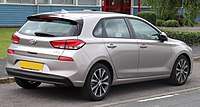 Five door
Five door Estate
Estate Fastback
Fastback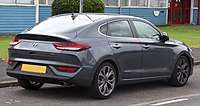 Fastback
Fastback Hyundai i30 N
Hyundai i30 N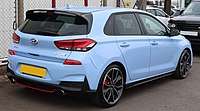 Hyundai i30 N
Hyundai i30 N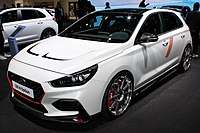 Hyundai i30 N Option
Hyundai i30 N Option Hyundai i30 N Project C
Hyundai i30 N Project C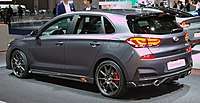 Hyundai i30 N Project C
Hyundai i30 N Project C Hyundai i30 Fastback N
Hyundai i30 Fastback N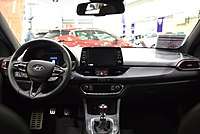 Hyundai i30 N Interior
Hyundai i30 N Interior
2020 Facelift
The updated Hyundai i30 range including the N Line Wagon was revealed in February 2020. Features include slimmer LED headlamps, 18-inch alloy wheels, 7-inch digital instrument cluster, 10.25-inch touchscreen infotainment system, and Hyundai SmartSense advanced safety package.[31]
The 1.0-litre T-GDI and 1.5-litre T-GDI engines are coupled with a 48-volt mild hybrid technology.[31]
Motorsport
Gabriele Tarquini won the 2018 World Touring Car Cup driving an i30 N, winning five races. His teammate Norbert Michelisz won a further championship in 2019.
i30 Sedan
The Hyundai Elantra (CN7) is sold as the i30 sedan in Australia.
References
| Wikimedia Commons has media related to Hyundai i30. |
- "Beijing Hyundai i30 debut in China". Autos.globaltimes.cn. 2009-09-09. Archived from the original on 2011-10-09. Retrieved 2011-09-19.
- "Thomas Bürkle". Hyundai Motor UK Ltd. Archived from the original on 2013-10-02. Retrieved 2013-08-12.
- "Hyundai i30" (PDF). Euro NCAP. Retrieved 2011-09-19.
- "Hyundai i30 | Euro NCAP – For safer cars crash test safety rating" (PDF). Euro NCAP. Retrieved 2011-09-19.
- Hyundai goes above and beyond when it comes to safety Archived 2011-07-18 at the Wayback Machine 14 April 2009
- Hyundai i30 is the safest imported mid–size car in Argentina December 19, 2008. [...]it was selected by CESVI (Center for Road Safety and Experimentation) as the safest mid–size imported car in Argentina. [...]
- Kon (2009-07-22). "New i30 launched at Hyundai Mega Motor Show". Autoworld.com.my. Retrieved 2019-03-03.
- "Hyundai i30 1.6 and 2.0 launched in Malaysia!". Paul Tan's Automotive News. 2009-07-22. Retrieved 2019-03-03.
- "Hyundai i30cw launched at Seoul Motor Show". Carscoop.blogspot.com. 2007-04-06. Archived from the original on 2011-10-01. Retrieved 2011-09-19.
- "Hyundai Elantra Touring". Hyundai.com.
- NHTSA – Hyundai Elantra Touring Archived December 5, 2004, at the Wayback Machine Search "Hyundai Elantra Touring"
- Blanco, Sebastian. "Hyundai's i30 blue will be first with ISG (stop start) technology". Autobloggreen.com. Retrieved 2011-09-19.
- "Hyundai i30 wins Car of the Year". Carsguide.news.com.au. Retrieved 2009-10-14.
- "Hyundai wins carsguide Green Car of the Year". Carsguide.news.com.au. Retrieved 2009-10-14.
- http://www.indiacar.net/news/n71077.htm 11/25/2007, Indiacar.com
- "Hyundai i30 and iMax named Australia's Best Cars". Autodeadline.com.au. Archived from the original on 2009-02-04. Retrieved 2009-10-14.
- Hyundai i30 is 2008 Car of the Year in Spain 2008-01-29
- "Hyundai Ireland The Hyundai i30 Wins Car of the Year 2008 Award in Spain". Hyundai.ie. Archived from the original on 2011-07-21. Retrieved 2009-10-14.
- "Drive's best cars of '08 – motoring – life-style". Press. Christchurch, New Zealand: Fairfax. Retrieved 2009-10-14.
- Hyundai i30 Wins AA Supreme Award Archived 2010-05-25 at the Wayback Machine 11 March 2009
- The Public Has Voted – Hyundai's i30 Is The Most Satisfying Car In Britain April 14, 2010. The Auto Channel
- Hyundai is the most satisfying car 11 April 2010. Telegraph
- KBB (Kelley Blue Book) Announces ‘Top 10 Family Cars for 2010′ Archived 2010-03-17 at the Wayback Machine February 17, 2010. Nitrobahn
- "2013 Hyundai Elantra GT delivers lightness, functionality – Autoblog".
- "Hyundai i30 and Veloster Turbo previewed at KLIMS, launching in 2014". Paul Tan's Automotive News. 2013-11-21. Retrieved 2019-03-03.
- Kon (2014-03-27). "Second-generation Hyundai i30 launched in Malaysia". Autoworld.com.my. Retrieved 2019-03-03.
- "Hyundai i30 hatchback launched in Malaysia - RM128k-133k". Paul Tan's Automotive News. 2014-03-27. Retrieved 2019-03-03.
- "All-New Hyundai i30 estate Unveiled Ahead of the Geneva Motor Show – Carscoop". Archived from the original on 2012-02-26. Retrieved 2012-02-24.
- https://www.autobip.com/cima-motors-pr%C3%A9sente-la-new-i30-made-in-dz-d%C3%A9tails-des-%C3%A9quipements-actualite-auto-algerie-d5376 Missing or empty
|title=(help) - Ruffo, Gustavo Henrique (2016-10-08). "Peter Schreyer teases new Hyundai i30". Motorchase. Retrieved 2017-05-26.
- Sagar (2020-02-28). "New Hyundai i30 range debuts with hot 'N Line' variants". autodevot.com. Retrieved 2020-04-14.